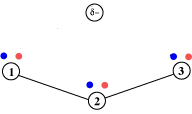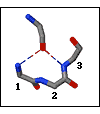Nest
Definition
A motif of three consecutive amino acid residues with dihedral angles 1,2-αRαL (RL-nests) or 1,2-αLαR (LR-nests). (The name derives from the observation that many nests have a depression or concavity in which an anion or δ-negative acceptor atom is bound by bridging from backbone nitrogen atoms.)

Sub-categories
- 1,2-αRαL (aka: RL)
- 1,2-αLαR (aka: LR)
Reference
Watson and Milner-White, J. Mol. Biol. 315:171-182 (2002)
Comments
1. Both N2N3- and N1N3-bridging (shown in the 3D view) occurs. However only N1N3 bridging results in a concave nest.
2. N1N3-bridging predominates in RL-nests, whereas N2N3-bridging predominates in LR-nests.
Occurrence
1. LR-nests are less common than RL-nests, and a smaller proportion of them exhibit bridging to anions or δ-negative acceptor atoms.
2. Nests frequently occur as parts of other motifs such as Schellman loops.
3. The anionic participant (the 'egg') is frequently a δ-ve O, although it can be the sulphur of an FeS cluster.
